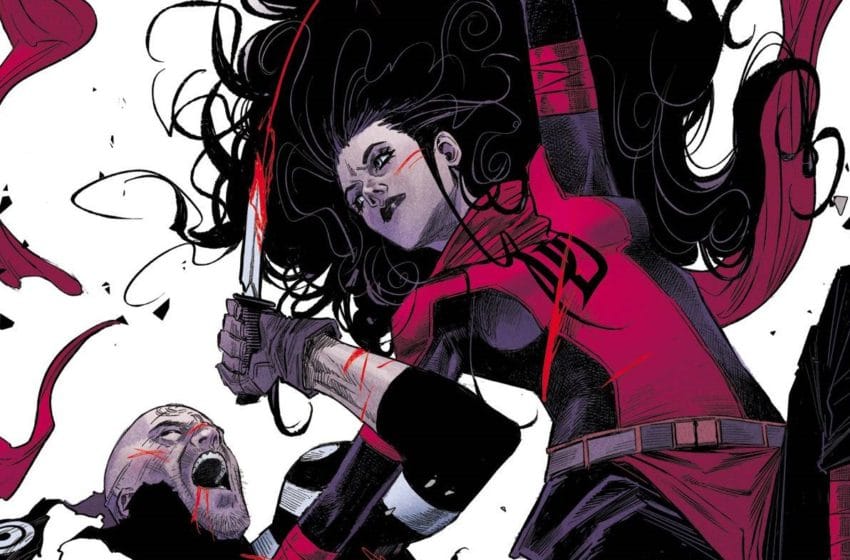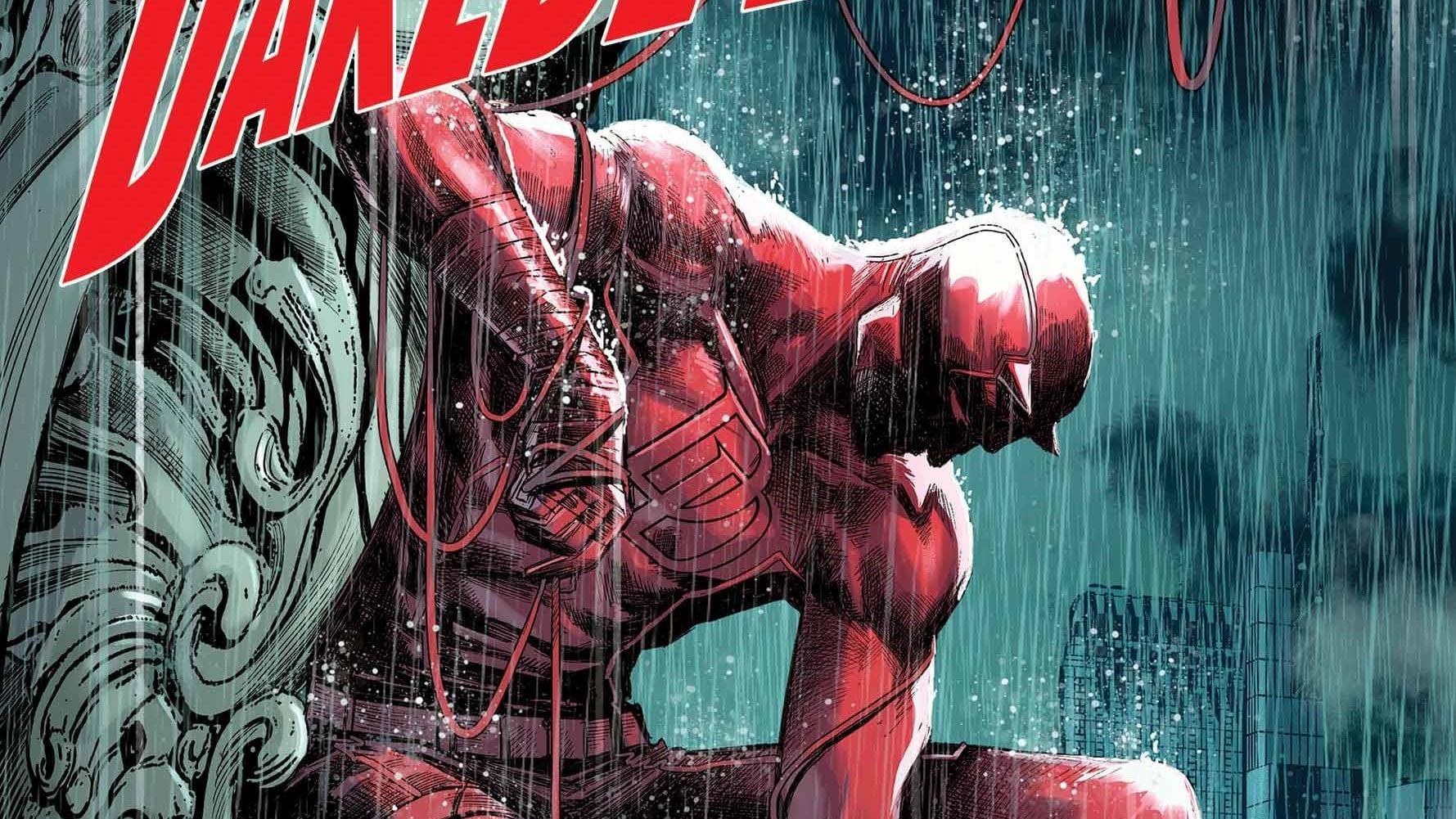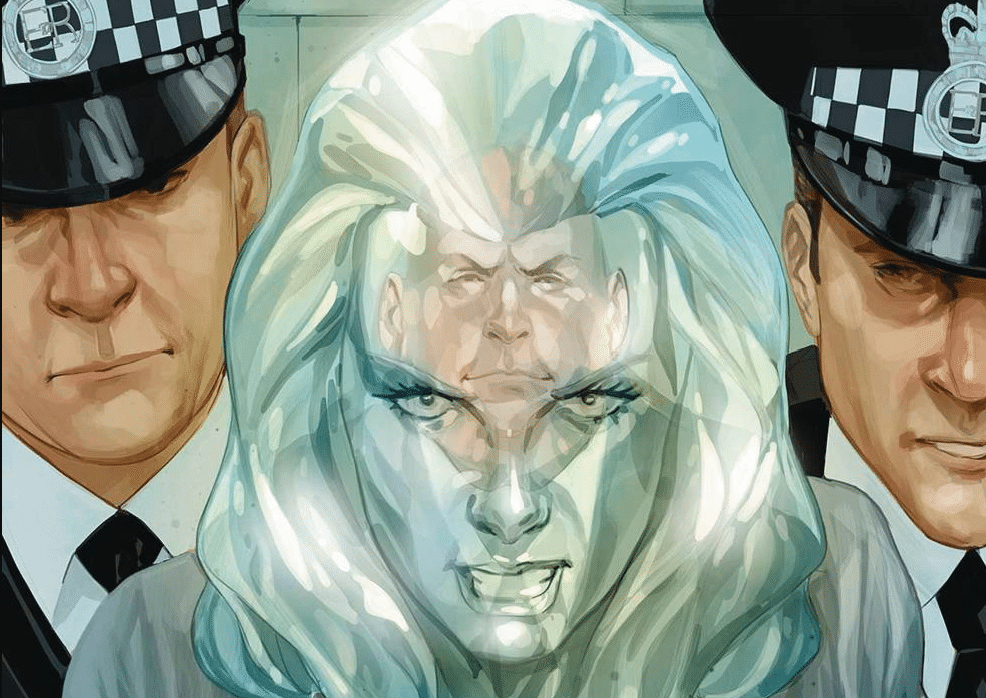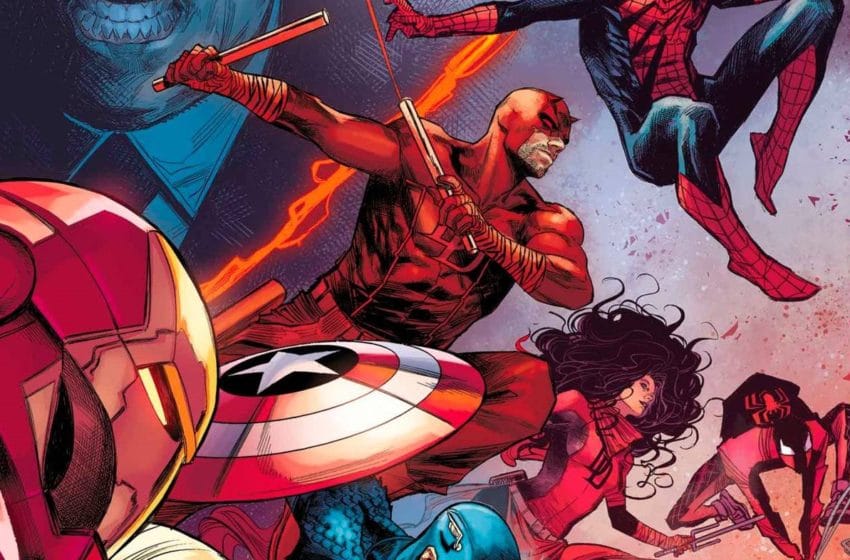Bonds are rekindled and scripts are flipped in Daredevil #35. Written by Chip Zdarsky, drawn by Stefano Landini and Francesco Mobili, colored by Marcio Menyz, and lettered by Clayton Cowles, Daredevil #35, part 5 of “Lockdown,” sees heroes getting help and villains getting themselves into new, old, and romantic forms of trouble.
Writing reviews of serialized monthly superhero comics is hard. Not hard the way my day job(s) are hard. (I consider writing about Daredevil more of a calling than a career.) But it is hard trying to have useful opinions about a story you’re only seeing in snippets, that’s riddled with deliberate gaps, red herrings, and cliffhangers. Complicating things further – sometimes the gaps aren’t deliberate. Sometimes gaps are just gaps. Comics are a fragmented form anyway, and monthly serialized superhero comics are collaborative, sprawling, and punishing. Most writers, artists, and editors do their best to tell complete, satisfying stories. But there are a lot of hurdles to doing so.
These inevitable gaps and hurdles place particular pressure on writing and talking about a serialized story’s beginnings and endings. Of course, where lucrative properties like Daredevil are concerned, beginnings and endings don’t really exist. Every new beginning isn’t actually new, every ending isn’t actually the end. Yet Daredevil #35 is the beginning of an ending of sorts; it’s the penultimate issue of this volume before we launch into Devil’s Reign, after which this series will presumably relaunch, at some point, into something else.
All of which is a roundabout way of saying: Daredevil #35 has to do a lot of stuff. It has to start wrapping up a multipart narrative steeped in decades of continuity in a way that feels satisfying, while simultaneously setting up the next big thing and resetting the status quo enough for that next big thing to start (relatively) fresh.
Does this issue accomplish all these things? No. That would be impossible. But it tries, and does some good things along the way. As I’ve discussed in previous columns, I’ve consistently liked this series more than I’ve loved it. But I’ve never doubted Zdarsky and Co. care deeply about the story they’re telling, and that care comes across here, in an issue that’s partly about learning to give a damn – about others and about yourself in relation to others, including people who hate you, people who love you, and people who want to get married even though everyone except them knows it’s a terrible idea.
Speaking of community – I’m writing solo this month, and we already know I’m feeling philosophical. Will I spend the entire column lamenting the fact Matt Murdock and Kirsten McDuffie’s drive from the prison back to Hell’s Kitchen happens entirely off-panel? Only one way to find out!
Setting the Stage

We begin where we left off, with Elektra and Typhoid Mary, both dressed as their own versions of Daredevil, confronting Bullseye and his sidekicks, who are, of course, more Bullseyes. It’s an attractive sequence, full of bombastic motion, well-placed close-ups, and evocative excess, as Landini and Mobili ably reference the style of regular series penciler Marco Checchetto without copying it. This series hasn’t been hurting for quality fill-in artists, with Menyz’s colors maintaining a consistent tone. This is also, despite its attractiveness, a challenging sequence, since we have to keep track of several Bullseyes fighting two women with curly dark hair dressed as Daredevil. But Mary doesn’t last long in the fight; after burning some stuff and launching a single spectacular sword volley, she disappears from the action. (We later learn she runs after one of the Bullseyes in an effort to protect her employer/lover Wilson Fisk.)
And that’s the problem I have with this sequence. Elektra and Mary finally meet, but never actually get a chance to work together. I would have liked to see that, at least for a while. But Mary’s not, apparently, motivated by a desire to help Elektra or save the city; she’s there to help Fisk. Bullseye observes as much, telling Mary, after he dodges her frontal assault, “I’ve never seen you like this,” which he ascribes to Mary’s relationship with Fisk. Obviously, Bullseye’s opinion on anyone’s motives (including his own) can’t be trusted. But the fact Mary quickly deserts the fight to find Fisk implies he might be right.
In previous columns, I’ve mentioned having issues with how Zdarsky writes Mary, and this is an example of why. Too often, Mary has been little more than a plot device in this series. She shows up when a fight needs extra color, has a moment, then fades into the background, often for several issues at a time. The way the series has handled Mary’s dissociative identity disorder is bound up in this. Her disorder sometimes feels like an excuse to make her do whatever the story needs, without explaining her motivations (or, more accurately – the motivations of whichever personality is dominant in that moment). In interviews, Zdarsky has repeatedly declared his fandom of the Daredevil run of Mary’s creator, Ann Nocenti. But I’ve often found myself wondering if Zdarsky really understands what made Nocenti’s Mary special. Nocenti’s Mary was a spectacular anarchic force rendered sympathetic by her backstory and by the fact she was exercising her anarchy in and against patriarchal expectations and restrictions, including those of Fisk and Matt Murdock, as well as the superhero genre itself. Nocenti’s Mary flagrantly defied both hero/villain binaries and gender binaries; those things were, in fact, inseparable in Nocenti’s take on the character.
The suggestion in this issue that Mary is more motivated and dangerous than she’s ever been because of her love for Fisk is, to put it mildly, not my favorite interpretation of the character. Back in the ‘80s, Mary fought and schemed her way into very nearly destroying Matt, both physically and psychologically. She’s never lacked power or motivation, but her motivation used to be chaos underpinned by feminist rage and revenge. Naturally, characters change, and Zdarsky has every right to put his stamp on Mary. But I’m also allowed to be disappointed by how he’s used her. I particularly dislike Mary’s fearful expression on this issue’s fourth page, as Bullseye leans close to sensually taunt her. Granted, this particular example is more of an art issue than a writing issue, but still – my favorite version of Mary would never be so easily manipulated by Bullseye, and definitely wouldn’t cower fearfully in the face of a sexualized threat. She would be the sexualized threat, humiliating Bullseye by laughing at the presumption his phallic weapons could ever subdue her.
But I digress. It’s entirely possible Zdarsky will later defy my expectations with Mary. Bullseye’s comments may also be read ironically – perhaps loving Fisk is making Mary weaker, not stronger, and maybe that’s the point. For now, I’m done griping about it (at least until the final section, when I gripe a little more about Mary saying “yes” to Fisk.)
Flipping the Script

Elektra fights the Bullseyes, and amid the confusion of the fight, Mary disappears. The Bullseyes also scatter, and Elektra follows them to a movie theatre, with a marque written in blood reading “Sai Crimes: A Tale of Two Beautiful Assassins.” It is obviously a trap, but of course it doesn’t matter; Elektra has to follow. Inside the theatre, Elektra finds a pair of tearful hostages, a man and a woman chained together in ill-fitting Bullseye and vintage Elektra costumes, occupying the stage. The real/original Bullseye says the man can go free if he agrees to re-enact one of his proudest moments – the time he killed Elektra with her own sai. I’ve complained about endless references to this event in a previous column, so I’ll refrain from doing so again here, except to say – at least this reference is explicit in its presentation of Bullseye impaling Elektra as a form of misogynist theatre, on which Elektra quickly drops the curtain.
Elektra does some nice strategizing in this sequence, using a combination of skill, force, tech, psychological manipulation, and a little help from a friend to get the upper hand on Lester. First, she uses the sais Tony Stark made her, which apparently produce a version of Matt’s radar sense, allowing her to take out two Bullseyes at range, without looking. I don’t really understand how this works, and don’t particularly care, because super-science is exactly that, and I’m usually happy to roll with it. But also – I don’t really know why Elektra would need such a weapon? Admittedly, her powers have always been vague and inconsistent. But Elektra trained with Stick and the Hand. She may not have Matt’s radar sense, but she has had, in the past, a quasi-magical spatial awareness that mimics it. I also kinda thought Tony made Elektra repulsor sais and… I’m kinda disappointed Tony didn’t make Elektra repulsor sais. Ah well.
I liked the next bits better, in which the woman held hostage in Elektra’s old costume knocks Bullseye off balance enough to stop him from shooting Elektra, and Elektra taunts Bullseye into killing the other Bullseyes. The real Lester subsequently books it back out to the street, facilitating a brief exchange between Elektra and the female hostage, in which Elektra thanks the woman for saving her life and actually pulls down her mask to smile as she does so. Elektra Natchios very rarely smiles in response to anything not related to sex or violence (though I suppose this technically qualifies as at least one of those), so this matters, and is clearly deliberate. I’m sure different readers will have different reactions to this exchange. On the one hand, a female hostage knocking a male killer off balance to help the hero is an arch cliché. On the other hand, the articulation of the cliché in this particular instance fits Elektra’s character journey, from absolute yet alienated freedom to a sense of responsibility and community.
Is it corny? Yes. Did I find joy in it anyway? Also yes. The first time Elektra died, she fought alone. But while she remains fiercely independent and determined to do things her own way, she’s not alone anymore.
Setting up the Sequel

While Elektra and Bullseye regroup, we touch base with Fisk and Izzy Libris, chatting on the phone from their respective homes. Fisk expresses his desire to distance himself from chaos and death, which you should never, ever do in a superhero comic, because it’s an obvious invitation to ironic comeuppance. As Fisk says goodbye to Izzy, a stray Bullseye lurks behind him.
Elsewhere, Elektra’s fight with the original Bullseye spills back into the street, where they almost have an old-fashioned shoot-out until Elektra does the right (and awesome) thing. She anticipates Bullseye’s trick shot and deflects it with her sai, so that it hits Bullseye in the leg. It’s great. Then, a special guest star crashes the party – none other than Matt Murdock, fresh from his prison break. He punches Lester a bunch of times until Elektra calmly stops him, relaying the obvious fact the fight is over. If we’re being real, it was over before Matt showed up, but I’m pretty sure Elektra knows that. When Matt asks Elektra why she stopped him, she offers another hint of a smile as she replies, “You needed help.” I’m a sucker for Elektra’s tranquility in the face of Matt’s senseless rage, and for this little sliver of wholesomeness in a book that hasn’t had a lot of that. If you’re worried this means Elektra’s done antagonizing Matt, don’t be; she calls him a fool on the next page.
The rest of the issue is essentially set-up for Devil’s Reign. First, a bunch of other supers, including Iron Man, the Fantastic Four, and Spider-Man show up. One might say “finally” since the Bullseye showdown had been going on for some time at this point, but I’ll allow it. An unnamed police-jerk with a pencil mustache who exists for no other purpose than to be extremely hateable wants to re-arrest Daredevil, but the other superheroes put the kibosh on that. And Daredevil lets them – that’s probably the most important part. Matt didn’t have to go to prison; at multiple points, he was offered legal and extra-legal help to avoid it. Now he’s finally, like Elektra, ready to accept help.
It’s hard to know how to feel about this conclusion, because a lot depends on what happens next – whether Matt legitimately learns anything from all this, and whether the stories to come continue deepening and expanding the institutional critiques this series tried to mobilize. For a while, Matt seemed to be reckoning with his privilege. But breaking out of prison after facilitating a violent prison riot only to have Tony Stark and Reed Richards show up to tell the cops you’re not going back sure exercises a lot of privilege! Granted, it’s more complicated than that. Matt’s worked hard to earn the support of these other powerful heroes, and the prison warden was dousing prisoners with experimental mood-altering gas and actively trying to kill Matt; justice would hardly be served by Matt going back to prison. But what about all the other prisoners who were mistreated? Will Tony and Reed be standing up for them, too?
Ben Grimm has words for Reed about their support for Daredevil putting them “on the edge of a cliff,” and warns they “need to be careful.” This is explicit set-up, since Devil’s Reign apparently involves Fisk outlawing superheroes. I feel like we already fought some Civil Wars about that, but no matter; I’m not in the business of critiquing stories before they happen. Which is why I’m going to keep my comments on this issue’s final scene as brief as humanly possible.
On the last pages of the issue, the last (?) Bullseye tries to kill Fisk. Mary shows up just in time to stop him, though Fisk still gets badly stabbed, and Mary still tumbles out the broken window of the highrise. Fisk saves Mary, then gathers her tenderly into his arms and asks her to marry him. A smitten Mary says yes. For all the reasons I outlined above, I’m not clamoring for this bit of Typhoid Mary character development, but for now, I’ll hold my peace. There’s lots of different ways this marriage plot could go. The fact the proposal occurs with Fisk bleeding all over Mary as she swoons in a pile of broken glass portends it won’t be wine and roses. But again – we’ll see. (Did I mention reviewing monthly superhero comics is hard?)
And that’s it! That’s the end! Of this issue, though not quite this series or this column. I’ll be back next month to talk about the megasized finale, teased on the final page of this issue by an image of Elektra and Daredevil, both in costume as Daredevil. I’m worried about Elektra being shunted aside for Matt after she’s worked so hard to make the Daredevil identity her own. But that’s another critique I’ll put a pin in for now, in favor of appreciating the fact that Matt and Elektra look nice together. They’re not my OTP (that would be Matt and Natasha Romanova, though this column knows I also love Matt and Kirsten). But still – they look nice.
Marvelous Musings
- Apparently, the reason Bullseye was able to remain un-findable for so long has something to do with his new mental instability, which in turn has something to do with him making scientists alter his brain to make him less predictable. This is a neat concept in theory, but there’s a reason I didn’t mention it above – because it doesn’t really factor into the story that’s told here, in which Elektra in fact finds Bullseye very predictable. Whether this has further ramifications is another “we’ll see.”
- Is Matt still being influenced by the “re-cid” drug? The explanation of how the drug works back in issue #34 suggests he would be, though he claims in this issue that he isn’t. Hm.
- There also hasn’t been much consideration of how re-cid might affect Matt differently because of his powers. Hm, again.
- Kirsten McDuffie was barely on panel in this issue, which is a shame, though I’m guessing she’ll play a larger role in the concluding chapter. (But also – if someone writes me a fanfic of that missing scene in the car, I won’t complain.)
- Butch and Mike Murdock were similarly off-panel, though Butch is mentioned in the phone call between Fisk and Izzy. I’m guessing we’ll see more of them in the finale, as well.
- Which of Mary’s personalities is agreeing to marry Fisk? That could matter later on.

Anna Peppard
Anna is a PhD-haver who writes and talks a lot about representations of gender and sexuality in pop culture, for academic books and journals and places like Shelfdust, The Middle Spaces, and The Walrus. She’s the editor of the award-winning anthology Supersex: Sexuality, Fantasy, and the Superhero and co-hosts the podcasts Three Panel Contrast and Oh Gosh, Oh Golly, Oh Wow!





